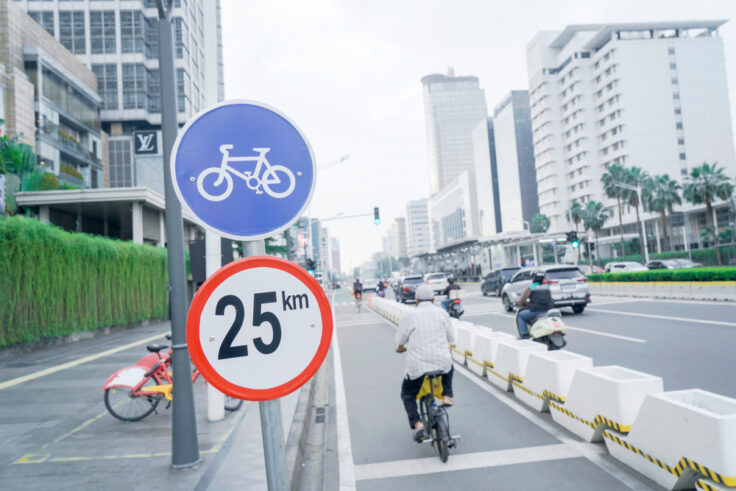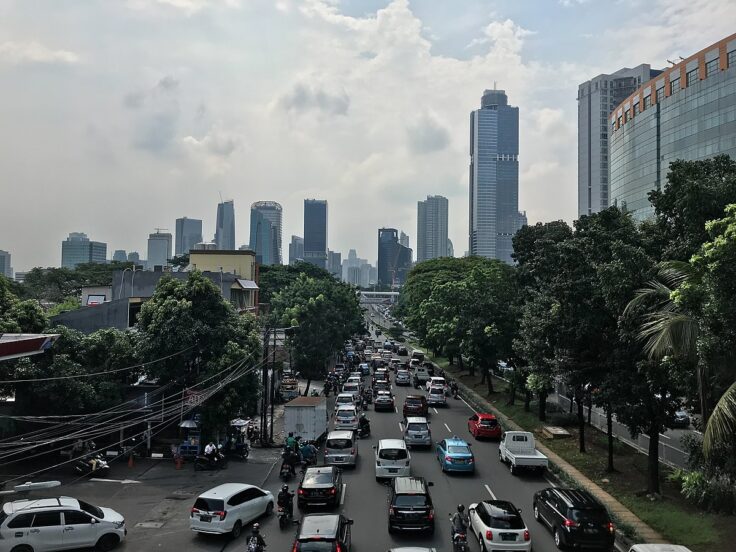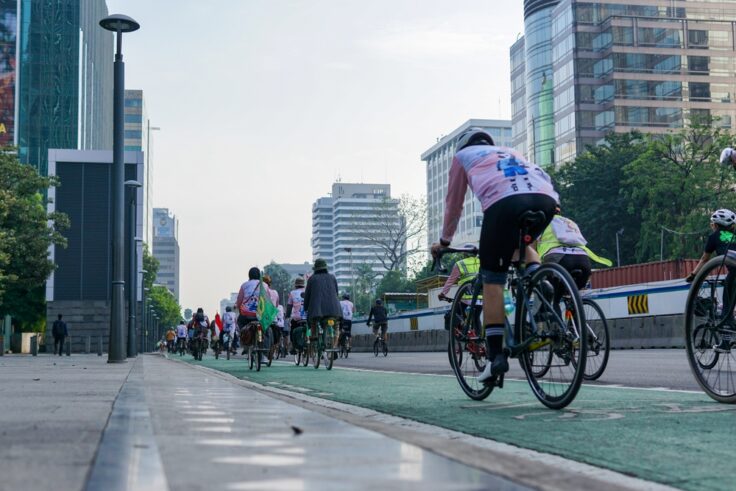December 08, 2023
Investing in Safe Cycle Lanes is Crucial to Jakarta’s Mobility Future
During the height of the COVID-19 pandemic, Jakarta implemented pop-up protected cycle lanes as one of its strategic responses to the COVID-19 pandemic.
The many climate and economic benefits of urban cycling can be realized by better protecting, integrating, and connecting cycling infrastructure.
Many lanes brought cyclists to the streets where they had never been before; in some cases, cyclist counts rose by 1,000% compared to pre-pandemic. An online survey and field interview conducted after implementing pop-up cycle lanes suggests that many people are willing to cycle to commute even longer distances, up to 11 kilometers, if the cycling infrastructure is built correctly. In early 2021, the Provincial Government of Jakarta committed to making the pop-up lanes permanent protected cycle lanes. This decision was met with enthusiasm from citizens and policymakers alike. A survey conducted by ITDP Indonesia of pop-up lane cyclists indicated that a protected or segregated cycle lane was the most requested facility and that unmaintained roads, aggressive drivers, and high vehicle speeds were top concerns.
However, Jakarta’s journey to becoming a cycling-friendly city has been no easy feat. In particular, cycling lanes alongside major car thoroughfares have been subject to public and political contention in the past few years. Based on ITDP Indonesia’s People Near Bikeways (PNB) study, bicycle routes built in Jakarta until 2022 have been connected to 165 Transjakarta BRT stops,19 KRL stations, 12 Jakarta MRT stations, 3 Jabodebek LRT stations, and 2 Jakarta LRT stations. The opportunities for modal shift of these types of rapid transit to cycling connections can rehelp reduce greenhouse gas emissions by an estimated 20,000 to 30,000 tons of CO2 by 2030, according to ITDP Indonesia.
The climate and economic benefits of cycle lane infrastructure can be realized by better protecting, integrating, and connecting bicycle routes, with support from complementary services like bike sharing, and through the implementation of Transport Demand Management (TDM) policies. While the Government of Jakarta has been successful in building a public transport system with service coverage reaching more than 85%, many air quality, emission, and congestion problems still exist in the city. The primary causes include high motorcycle usage on short trips to and from public transport hubs (first and last mile travel). In Jakarta, motorcycles are the highest contributor to air pollution per person and the second highest GHG emissions, based on 2023 research from ITDP Indonesia. Bicycles and e-bikes have great potential to be an alternative mode for first and last mile trips, rather than emissions-heavy two-wheelers.

Cycle Lane Usage Is High, Despite Declining Quality
Despite the great potential and interest in cycling as a transport mode, the Government of Jakarta has not been prioritizing protected infrastructure. Instead of improving the quality of cycle lanes with more permanent materials such as concrete, the city has reduced the quality of protection from stick cones to road spikes (also known as cat eyes). This change means that both the function and typology of the bicycle lanes have effectively gone from protected to unprotected.
Based on a survey evaluating the use of bicycle lanes in Jakarta by ITDP Indonesia in 2022, 94% of cyclists would feel more confident cycling with protected bicycle lanes. Moreover, almost 50% of cyclists traveling short distances were found to be beginner cyclists. In October 2023, in the context of maintaining bicycle lanes, stick cones were replaced with road spikes on thirteen protected bicycle lanes by Jakarta’s Provincial Transportation Agency. Although the durability of stick cones is vulnerable due to the temporary nature of the material (not permanent), the presence of stick cones can, at the very least, physically limit the conflict between cyclists and vehicles. Road spikes, however, provide the bare minimum of protection. This lack of priority for truly safe infrastructure is especially concerning for the city’s current and potential cyclists. ITDP Indonesia’s findings have shown that, among beginner cyclists, permanent physical barriers can increase confidence by up to 67 percent.
If the government’s purpose of replacing stick cones with road spikes is to improve cyclist safety, more permanent and durable physical protection (such as concrete curbs) should be the focus instead. ITDP Indonesia assessed the current conditions of the thirteen bicycle lane sections in October, and identified that the segments should have a protected or partially protected typology based on the Transportation Agency’s 2022 plan. However, as the Agency gradually removed stick cones, it reduced the length of the protected bicycle lane segments by more than 18 kilometers. This also occurred on main bicycle lanes, totaling 63 kilometers in 2019.
Even following the cycling boom of 2020, cyclists are still found along many of these lanes, even though only four have been constructed as permanent infrastructure despite advocates recommending nearly 50 protected lane segments. In residential areas like Pemuda, Cipete, Tomang, and Cideng, there are nearly 50 cyclists using local lanes per hour, according to ITDP Indonesia counts. Office and commercial areas have also observed almost 130 cyclists per hour, despite many bicycle lanes being only implemented by markings. The regular, daily usage of cycle lanes underscores the persistent need for better, safer infrastructure. However, Jakartans continue to be exposed safety risks with unprotected lanes, including vehicles swerving, speeding, or parking in them.

Recommendations for Protecting Jakarta’s Cycle Lanes
There is ample potential to encourage more cycling in Jakarta, especially among marginalized or low-income groups, as a sustainable transport solution. If the quality of lanes are improved with continuous concrete protection and supporting facilities, such as bicycle parking and traffic enforcement, cycling can be viewed as an essential mode. As Jakarta has committed to significantly reducing emissions by 2030, the city urgently needs to leverage opportunities to improve the quality of its cycle lanes by implementing permanent curbs, better protection for cyclists, and road safety policies. Replacing stick cones with road spikes, as the city is currently doing, will only serve to compromise public safety and negatively influence public perceptions of cycling.
As ITDP Indonesia has highlighted in reports, the implementation of safe cycling facilities is not only limited to on-bicycle lane markings, but also includes measures like intersection redesign, sidewalk design, bus stop adjustments, and traffic enforcement for both cyclists and drivers. The provision of bicycle infrastructure should be followed by monitoring and evaluation activities to meet the needs of bicycle lane users, not non-users, in order to improve the quality of bicycle lane design. Monitoring and evaluation activities should assess factors like:
- Quality and suitability of implemented designs to user requirements;
- Impacts felt by beneficiaries (active mobility actors) rather than motor vehicles; and
- The performance and effectiveness of the design is seen from the behavior of cyclists when using the bike lane.

To further encourage cycling and cycle lane usage, the government should accelerate the implementation of bikeshare programs that can address first and last-mile transport issues and vehicle accessibility. In addition, implementing better policies to control and limit motorized vehicles, such as parking reform, electronic road pricing, and low-emission zones, can increase public support for cycling infrastructure. Of course, the overall provision of reliable public transport services and complete streets designed for pedestrians and cyclists is key to a more sustainable, equitable future for Jakarta.
Bicycle lanes have often not been treated as significant pieces of urban infrastructure in the same way as metros, BRT systems, and highways. Networks of protected bicycle lanes should be considered essential to megacities like Jakarta—they are efficient, cost-effective, and easy-to-build investments for protecting the climate and increasing transport efficiency. Jakarta’s transport planners, officials, and decision-makers urgently need to recognize that investing in more, not fewer, protected cycle lanes will help establish cycling as a safer, more sustainable, and more affordable means of mobility for all.
Access ITDP Indonesia’s Technical Notes on the Sustainability of Jakarta Bicycle Lanes for more recommendations for the city’s cycling infrastructure.
